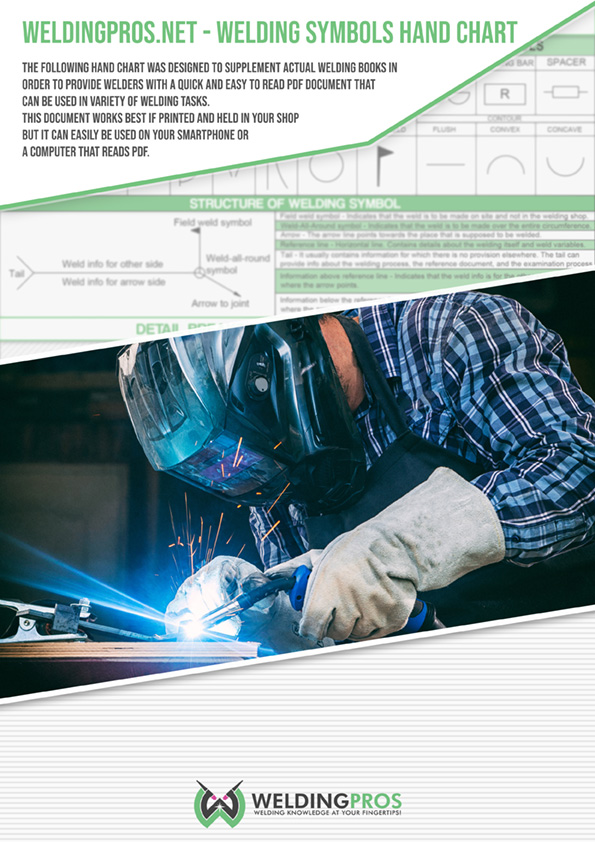From all my years of welding, I came to realize that protection is the most important part of our line of work. We may work with our hands but our eyes and head are the parts that are most in danger. That’s why the first question that you have to ask is – Where is my welding helmet?
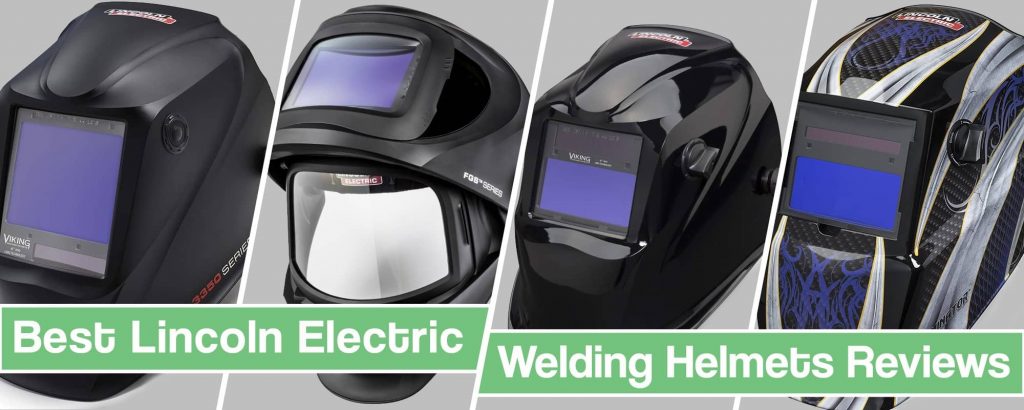
There are a few brands that offer top-notch protection and today I want to point out Lincoln products specifically. I had a chance to work with a lot of Lincoln welding helmets and personally think that they are really good and affordable. But you still can’t take just take the first Lincoln helmet you come across and be down with it.
That is why I have decided to compound a list of Lincoln welding helmet reviews and aid my fellow welders in their search for proper protective equipment.
I promise that by the time you finish this article, you will have a full picture of the best welding helmet for you.
Best Lincoln Welding Helmets Comparison Table
| Image | Name | Shade Selection | Arc Sensors | Viewing Area | TIG Amp | Weight | Check Price |
|---|---|---|---|---|---|---|---|
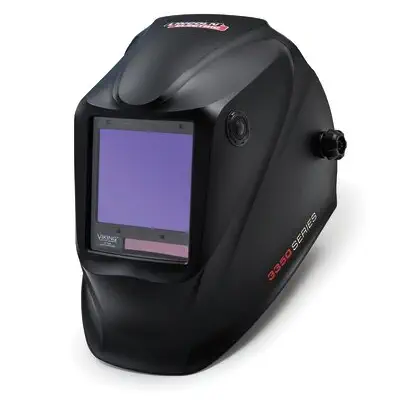 | Lincoln Electric Viking 3350 | DIN 5-13 | 4 sensors | 12.5 square inches | 2 Amps | 20.98 oz. | Check Current Price Amazon |
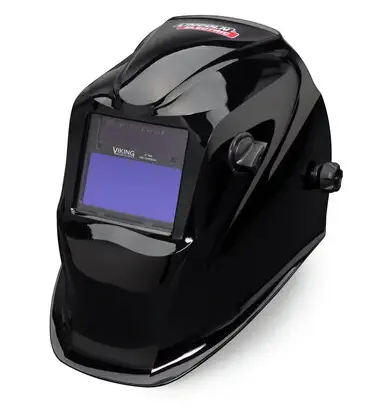 | Lincoln Electric Viking 1840 | DIN 9-13 | 2 sensors | 3.78in x 1.85in | 2 Amps | 18 oz. | Check Current Price Amazon |
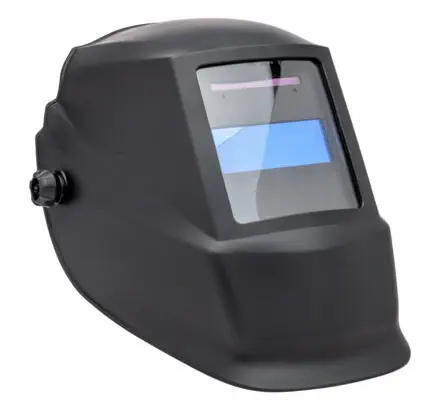 | Lincoln Electric K3419-1 | DIN 7-13 | 2 sensors | 3.82 in x 1.73 in | 5 Amps | 17 oz. | Check Current Price Amazon |
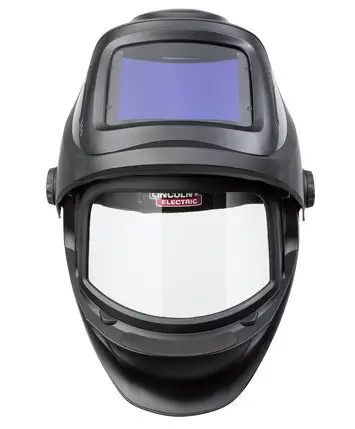 | Lincoln Electric 3250D FGS | DIN 5-13 | 4 sensors | 2.95 in x 4.25 in | 2 Amps | 28 oz. | Check Current Price Amazon |
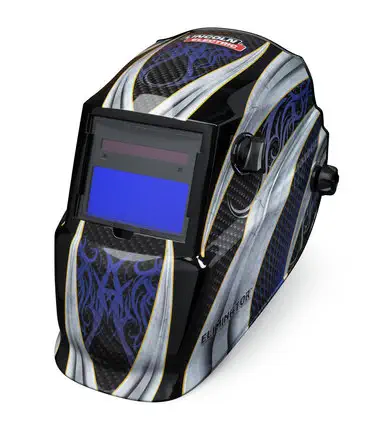 | Lincoln Electric K3320-2 | DIN 7-13 | 2 sensors | 3.82 in x 1.73 in | 5 Amps | 17 oz. | Check Current Price Amazon |
Best Lincoln Welding Helmet Reviews
Lincoln Electric was founded way back in 1895 in Cleveland, Ohio. The founders originally used a $200 investment to develop and commercialize a direct current electric motor for industrial applications. Today, Lincoln is one of the leaders when it comes to making welding and cutting equipment.
Lincoln helmets in particular have been getting a lot of attention in recent times, so it makes sense for me to review them as there is a huge demand. So let’s start with my top choices.
1. Lincoln Viking 3350 – The Best Lincoln Welding Helmet

The Lincoln Viking 3350 welding helmet has to be one of my favorites on the list, specifically because of the clarity and viewing area. With this helmet, you don’t have to try and put a weld while praying to God that the bead is in the right place. The helmet allows you to see the weld area as clear as day. You can even see the landscape around the weld and I am not missing the green glow that you have with other helmets.
The sensitivity and delay controls work perfectly due to the included 4 arc sensors.
There is a long delay after carbon arcing that gives the carbon glow some time to dim down, which is perfect when trying to trigger a weld fast. The hood boasts an incredible battery capacity as it comes with replaceable lithium batteries and solar backup.
Compared to some other products in the same range, like the ESAB, the Lincoln Electric welding helmet is a lot more rugged. The ESAB only takes the cake when it comes to TIG, but the Viking reigns supreme everywhere else.
The controls of the Viking 3350 are literally dummy-proofed. There is a big external grind mode button, that the previous model didn’t have, that you can turn on even when wearing gloves. But the headgear is not good at all. The helmet will fall right off if you weld out of position, do overhead welding, or lean forward too much. Nevertheless, it is really durable even with the head harness of the Viking 3350 being made out of plastic.
Visit this post you want to find out more about this popular Lincoln helmet.
Pros & Cons Summarized
Pros
- High level 4C lens clarity
- Large view area
- Precise delay and sensitivity controls
- Rugged build and super durable
- Large external grind button is easy to press with gloves
- Maybe the best, but certainly most popular helmet on market
- 3-year warranty with increased battery life
Cons
- DC TIG sensitivity can be better
- Headgear is comfortable but it won’t stay on for a long time
Specifications
- Optical Clarity: Perfect 4C 1/1/1/1 optical clarity rating
- Shade Selection: DIN 5-13 shade with internal control
- Controls: Delay and Sensitivity controls with Grind mode
- Sensors: 4 Arc sensors
- Viewing Area: 12.5 square inches
- Compatibility: Hard Hat and Cheater Lens Compatible
- TIG Amp Rating: 2 Amps
- Power Source: CR 2450 Battery + Solar Cell
- Light to Dark Switching Time: 1/25000 sec.
- Weight: 20.98 oz.
2. Lincoln Viking 1840 – Great Value Welding Helmet

I actually had a chance to use the old-style Lincoln Vikings 1840 helmet, and I can say that they have done an excellent job on making improvements for the new one. The new style headgear sits a bit further back from the lens and feels a lot comfortable. The shade of the new welding helmet darkness a lot faster thanks to the improved electromagnetic sensor. Tacking is a lot more precise, particularly when working in shades.
Compared to other auto-darkening welding helmets on my list, this one is really good for a hobby welder.
Particularly as it offers improved pre-weld visibility and overall better control of the arc.Perfect for MIG welding work and the helmet weight is very comfortable. Adjusting the helmet between welds is also very convenient. The quality of the helmet can be compared with Miller hoods and the all the features are very easy to use.
The main drawback would be that it may be a bit of a too lightweight helmet, and thus not rugged enough. Also, it comes with only two arc sensors compared to other buckets. So due to it coming with only two arc sensors, I feel that the price is a bit too much. But the solar-powered assist with a replaceable lithium battery is a nice fit and makes it a good welding helmet.
Pros & Cons Summarized
Pros
- Great natural color lens allows you to control the puddle
- Large external shade control and grind button which is easy to use
- Lightweight
- Noticeable improvement over older 1840 helmet
- Great value for hobby welders
- 3 year warranty
Cons
- Only 2 arc sensors which can be blocked in cramped spaces
- Not rugged enough
Specifications
- Optical Clarity: Perfect 4C 1/1/1/1 rating
- Shade Selection: DIN 9-13 shade with external control
- Controls: Sensitivity and Delay with Grind mode
- Sensors: 2 Arc sensors
- Viewing Area: 3.78in x 1.85in
- Compatibility: Hard Hat and Cheater Lens Compatible
- TIG Amp Rating: 2 Amps
- Power Source: Battery powered with solar assist
- Light to Dark Switching Time: 1/25000 sec.
- Weight: 18 oz.
3. Lincoln Viking K3419-1 – Great Welding Helmet for Beginners

The Viking K3419-1 auto-darkening welding helmet is not your typical entry-level welding helmet in terms of its price. For instance, it costs twice as much as an Antra but offers twice as much in terms of quality. It offers an almost seamless transition from undimmed room light to a dimmed arc light. But it was slow to darken.
If you happen to do some work only 2-3 times a month, this one will do quite nicely. You may need to spend more but you will get improved optical clarity.
Plus, it is not robust but lightweight enough so it doesn’t weigh on your head so much. It actually looks quite solid based on its weight. The field of view is not huge, but more than enough. Also, I love that the dimming know is placed on the outside, which allows welders to go from welding to grinding a lot easier. Also, it requires standard AAA batteries available anywhere and solar power assist.
Lincoln products are in my experience more dependable as far as the welding industry goes, and the same thing goes for their auto-darkening helmets. If you are in two minds about getting the right welding helmet for DIY work, this one should be your choice. It comes with the most necessary features for hobbyists.
Pros & Cons Summarized
Pros
- Improved clarity for a budget helmet
- Large external buttons which are easy to operate
- Best value for entry level and occasional welders
- Lightweight and compact
- Dependable helmet with fast ADF feature
- Uses standard AAA replaceable batteries
Cons
- Small viewing area
- Not rugged enough
- Only for occasional use
Specifications
- Shade Selection: DIN 7-13 shade with external control
- Controls: Sensitivity and Delay with Grind mode
- Sensors: 2 Arc sensors
- Viewing Area: 4.3 in x 3.54 in
- Compatibility: Magnifying Lens Compatible
- TIG Amp Rating: 5 Amps
- Power Source: AAA Battery powered with solar assist
- Weight: 17 oz.
4. Lincoln Electric Viking 3250D FGS – Industrial Level Welding Helmet

The Lincoln Electric Viking 3250D FGS is as near to a professional welding helmet as you can get. It is very easy to wear although a bit heavier than the manual suggests. You are not going to need to take it off during breaks. The auto-darkening helmet is easy to configure and I suggest you do that as I found that the default settings are not that good.
Also, it is multipurpose meaning that it can be used for any welding process you need it for. Having the grind welding mode helps and saves on time when having to constantly switch from the helmet to a face shield. The lens clarity is very good, thanks to the Lincoln 4c technology. The auto-darkening filter is top quality and the peripheral view is more than acceptable.
What I didn’t like is that the electromagnetic sensors are partially blocked by the cover of the outside lens. You can easily end up catching some arc light, particularly when TIG welding. That’s why I wouldn’t recommend it for people that are going to TIG weld with it as you might get frustrated by constantly being caught by the light. It is also a bit wide, so it probably does not fit when trying to slide in some tight spaces.
The welding helmet Lincoln Electric helmet doesn’t use AAA batteries but does have solar power assist and uses 2 CR 2450 lithium batteries. It comes with a helmet bag, which is to be expected, but the three-year warranty is something that you also don’t see that often.
However, this is a welding helmet Lincoln Electric product that comes with a very good warranty.
Pros & Cons Summarized
Pros
- Superior 4C lens optical clarity
- Digital controls are easy to use and set up
- Industrial level helmet
- Flip up lens with face shield for easy cutting and grinding
- Great 3-year warranty
- Anti-fogging system
- Shade 5 side shields improve peripheral vision
Cons
- Not great at TIG welding
- You should tune default settings
- Flip up can be troublesome
Specifications
- Optical Clarity: 4C 1/1/1/1 clarity rating
- Shade Selection: DIN 5-13 shade with internal controls
- Controls: Flip Up Lens with Cut and Grinding mode shield
- Sensors: 4 Arc sensors
- Viewing Area: 2.95 in x 4.25 in
- Compatibility: Hard Hat and Cheater Lens Compatible
- TIG Amp Rating: 2 Amps
- Power Source: 2 CR 2450 Batteries with Solar Assist
- Light to Dark Switching Time: 1/25000 sec.
- Weight: 28 oz.
5. Lincoln Electric K3320-2 Welding Helmet

This is one of the best Lincoln welding helmets for budget welders. You literally don’t have to worry about blind starts which occur with non-automatic models. The viewfinder is a bit small, but you can’t expect a larger one for this price.
Also, the auto-darkening feature with dial setting is too smooth and that welders can easily turn the darkening up a notch accidentally without wanting it.
A clicking dial would work better in my opinion, which works better even with gloves on your hands.
I advise going against buying a cheaper option like the same level Yeswelder as you will soon realize that this one should have been your primary choice all along
You can feel that the weight is spot on the second you put it on. Also, it fits comfortably well and I recommend using it for long hours of work.
The headpiece may be a bit off so more adjustments may be needed. I noticed that the tension knob at the back of the helmet is a bit problematic to set right. You can’t really get a tight, snug fit with it so you might end up constantly fiddling it. But still, you can write this off solely based on the price.
Nevertheless, it is one of the best helmets that can be used for a variety of welding processes at an excellent price.
Pros & Cons Summarized
Pros
- Great clarity for a budget helmet
- Great value for entry level and occasional welders
- Really comfortable and lightweight
- Uses standard AAA batteries with solar cell assistance
- Large external control buttons
Cons
- Small viewing area
- You need to fine tune ADF
- Headgear can be hard to set up
- Printed graphic resolution is not that high
Specifications
- Shade Selection: DIN 7-13 shade with external control
- Controls: Sensitivity and Delay, Test Button
- Sensors: 2 Arc sensors
- Viewing Area: 3.82 in x 1.73 in
- Compatibility: Magnifying Lens Compatible
- TIG Amp Rating: 5 Amps
- Power Source: AAA Battery powered with solar assist
- Weight: 17 oz.
How to Choose the Best Lincoln Welding Helmet – Buyer’s Guide
The best Lincoln welding helmets come with 4C lens technology. It upgrades the optical clarity, real color view, allows even shade from every angle, and is lightweight. It is used to upgrade the Lincoln Vikings 1840 series, 2450 series and 3350 series helmets. It reduces the lime green coloring that a lot of helmets have problems with and improves overall visibility on these hoods.
I would say that the 4C lens technology will come in handy in industries like power generation, general fabrication, offshore, structural and pipeline welding, and shipbuilding.
3350 Series Welding Helmets
The 3350 Viking Series helmets are the top-quality helmets created by Lincoln. These possess absolutely the best optical clarity and the largest viewing area in their class. The 4C lens technology can upgrade the view screen of 3350 series helmets to a 1-1-1-1 optical clarity rating and reduce the lime green tint.
1840 Series Welding Helmets
The 1840 series helmets also boast one of the best optical clarity parameters available today. On the plus side, external controls are there for quick shade changes by welders. These can also be upgraded with the help of 4C technology so the optical clarity reaches a 1-1-1-1 rating and improving the overall visibility of the lens.
FGS Series Welding Helmets
The FGS series is described as the most technologically advanced series, and it truly is. It adds an integrated grind shield for grind mode, industrial leading optical quality, and side windows. The hoods in these series are meant for professionals as they have added productivity and safety benefits. They come with an optical design that reduces color saturation and improves the view of the weld puddle and arc.
2450 Series Welding Helmets
The 2450 series helmets are the latest addition to the fleet of Lincoln products. These include the latest upgrades in the auto-darkening lens technology and have adjustable sensitivity. Additionally, these are lightweight helmets and come with improved headgear. These too can be upgraded with the 4C technology and obtain a 1-1-1-1 optical clarity rating and reduce the lime green tint.
1740 Series Welding Helmets
When it comes to the 1740 series of helmets, they definitely don’t lack any features. If you want to look good while welding, then know that these come in a glossy black finish but can be upgraded to fit your personal style with a decal sheet. As far as technology goes, these come with continuously variable 9-13 shade with internal control and 1/1/1/2 optical class rating.
Conclusion
This would be my list and I hope you are as happy with it as I was. This is not all, there are other welding helmets out there of course, but I feel that these are the ones for you to check out first. A great helmet doesn’t have to come with a big price tag nor a lot of features. You need to choose a hood that fits your needs and all experienced welders are going to tell you this. Now it is up to you to make the final decision. There are other great welding helmets from other brands reviewed in this article if you are still undecided




